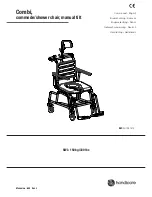
TECHNICAL SPECIFICATIONS – RIGID WHEELCHAIRS | USER MANUAL
15
T
1 866 650-6555
F
1 888 966-6555
1
INFORMATION
Note that for the unilateral wheel lock, the engagement or
disen gagement of the wheel lock is done on one side only.
7.3 FOOTREST
7.3.1 ADJUSTING THE FOOTREST HEIGHT
• The
APEX is equipped with a single footrest plate.
• Make sure to remove any load from the footplate.
• Loosen the bottom right and left stem-to-frame bolts.
• Adjust the height of the footplate in the limits of + or - 1’’
range.
• Tighten the screws to the specified torque.
• Make sure the footplate is secure.
7.3.2 FOOTPLATE OR OPEN LOOP
• When transferring, avoid putting weight on the footrest or open
loop and be careful not to stand behind the footrest.
• Never use the footplate or open loop to lift the wheelchair when
occupied.
• Only use non-detachable parts to lift the wheelchair.
7.4 ARMRESTS
WARNING
Ensure that armrests are securely locked into arm sockets
and armrest release buttons are locked into place prior to
using the wheelchair.
• Never lift the wheelchair by holding the armrests.
• Only use non-detachable parts to lift the wheelchair.
7.4.1 FLIP BACK ARMREST
The flip back armrest is not available on the APEX. Use only the "T"
armrest on the APEX.
7.4.2 REMOVABLE "T" ARMRESTS
To remove the armrests:
• Pull lever (1) backwards to release the system.
• Pull the armrest all the way up.
To reinstall the armrests:
• Bring the armrests downward until slide (3) enters in the arm-
rest receiver (4) and snaps into place.
• Make sure locking lever (2) is engaged to avoid any movement.
7.4.3 SWING AWAY ARMRESTS
To remove the armrests from the wheelchair:
• Lift them straight up to release the armrest from receiver (1).
• To reinstall the armrests, insert them back in the armrest
receiver (1) until they snap into place.
1
7.5 SEAT BELTS
WARNING
Use positioning belts ONLY to help support the user's pos-
ture. Improper use of these belts may cause severe injuries
to the rider.
WARNING
Ensure that the user does not slide down in the wheelchair
seat. If this occurs, the user may suffer chest compression or
suffocation.
WARNING
Never use belts as a motor vehicle restraint.
• The seat belt should be used at all times in accordance
with instructions.
• There should be approximately one hand width of space
between the seat belt and thigh; do not exceed this amount of
space.
• Make sure the seat belt is properly fastened to avoid serious
injuries.
• In case of emergency, ensure that the seat belt can be easily
unfastened.
7.5.1 AUTO BUCKLE AND AIRCRAFT BUCKLE SEAT BELT
• To fasten your seat belt, insert the clip into the buckle until it
snaps.
• Make sure the belt is securely fastened.
• To unfasten your seat belt, lift the flap on the aircraft buckle
seat belt or push the button on the auto buckle seat belt.
• To adjust your seat belt, pull each strap towards the opposite
side until you get the desired tension and keep the buckle cen-
tered.
7.5.2 VELCRO BELT
• To fasten your seat belt, insert the long side of the seat belt into
the buckle on the other side.
• Apply pressure on the belt for a firm grip of the Velcro.
7.6 ANTI-TIPPERS
RECOMMENDATION
Motion Composites strongly recommends the use of anti-tip-
pers. Anti-tippers were designed to prevent falls from the
wheelchair.
• To remove or rotate the anti-tippers up, push the release
button (1) and pull out or rotate the anti-tippers (2).
• To replace the anti-tippers, press the release button and insert
them into the frame until they snap into position.
















































